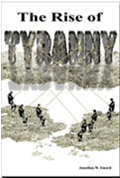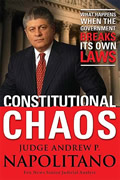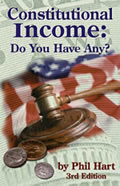THOUGHTS
ON PART TEN OF “A CONCURRING OPINION”
PART 10
By
Dr. Edwin Vieira, Jr., Ph.D., J.D.
April 8, 2010
NewsWithViews.com
Timothy Baldwin’s “A CONCURRING OPINION FOR SECESSION (Part 10)” introduces the new argument that a State’s supposed “right to secede” from the Union does not depend upon any procedures within the Constitution (such as the process for amendment in Article V), and presumably does not depend on upon conditions being such that the principles of the Declaration of Independence apply, either. Unfortunately, I cannot concur in these contentions.
1. Mr. Baldwin correctly asserts that, after the Declaration of Independence, “[t]he states were independent, sovereign and free and had the power to enter into compacts with each other, as they did in the Articles of Confederation and the US Constitution”. However, he fails to recognize an important consequence of the States’ status: namely, that, being “independent, sovereign and free”, the States could also fashion such “compacts” as they wished, and therefore could limit each participating State’s “right to secede” from their “compact” except under certain specific conditions, or even exclude such a “right” entirely.
So, quite beside the point is his general statement that “[g]iven the status of these states as independent and free states, they necessarily have the power to do what independent bodies-politic have: the power to make (accede to) and unmake (secede from) constitutions”. Yes, States have such powers, unless explicitly or implicitly they have surrendered or limited them in their “constitutions”. And to determine whether this has happened in any particular instance, one must look to the specific terms of the particular “constitution” in issue, not simply generalize about “powers” that States may have unless they have relinquished or waived them through “compact”.
2. Mr. Baldwin then claims that,
under the Articles of Confederation, the states retained all powers not expressly delegated to the federal government, and it is clear that they did not delegate the power to secede, which all sovereigns have. Its [that is, the Union’s]“perpetual” duration [under the Articles] had nothing to do with the right and power to secede.
Now, first and foremost, “all sovereigns [do not] have” “the power to secede” from “compacts” into which they freely enter and in which they agree not to “secede”, or agree to limit their “right to secede”. So, the question is, “What did the Articles of Confederation—which constituted a “compact” among the original thirteen States—provide as to “secession”? Mr. Baldwin contends that the relevant part of the Articles of Confederation, Article XIII, “had nothing to do with the right and power to secede”. Really? How one can read the language of Article XIII and come to that conclusion escapes me. Article XIII provided that
[e]very state shall abide by the determinations of the united states in congress assembled, on all questions which by this confederation are submitted to them. And the Articles of this confederation shall be inviolably observed by every state, and the union shall be perpetual; nor shall any alteration at any time hereafter be made in any of them; unless such alteration be agreed to in a congress of the united states, and be afterwards confirmed by the legislatures of every state.
Taken literally (and no reason exists not to take it literally), this plainly meant that, to terminate any State’s participation in the Articles—which necessarily would entail inter alia that State’s refusing any longer to “inviolably observe[ ]” the Articles—each State had to agree both collectively in Congress and individually through some separate legislative statement of her own. Thus, the supposed unilateral “right” of a State to “secede” was expressly denied—or, to use Mr. Baldwin’s language, the “power” of “secession” was transferred from each individual State to Congress and the totality of the States, such that each individual State retained no part of that power capable of being exercised by herself alone. If one can find a surviving unilateral legal “right to secede” in or somehow recognized by the language in Article XIII, he is more clever than I am at parsing legal texts. Moreover, precisely why “sovereign” and “independent” States, in making this “compact” amongst themselves, could not have limited their “right to secede” in exactly the manner in which Article XIII expressly limited it, Mr. Baldwin does not tell us. His argument seems to reduce to the exhortation, “Yes, it actually says that; but don’t believe it!” I should take that as good advice with respect to statements emanating from today’s Congress. But I am less inclined to approach the organic laws of this country, penned by the Founders, in such a spirit of disbelief.
3. Mr. Baldwin then argues that, “[b]y virtue of the US Constitution being drafted, proposed and ratified, those states that assented to the US Constitution seceded from the old union under the Articles of Confederation, despite its duration being perpetual”. There is, however, another explanation for what happened: namely, that all of the original thirteen States remained legally bound by the Articles of Confederation until the last of them had ratified the Constitution. That is, none of them actually “seceded” from the Union under the Articles of Confederation at all. Rather, they went forward in substantial compliance with the procedure set out in Article XIII—namely,
(i) On 21 February 1787, the Congress operating under the Articles of Confederation resolved that:
Whereas
there is provision in the Articles of Confederation & perpetual
Union for making alterations therein by the assent of a Congress of
the United States and of the legislatures of the several States; and
whereas experience hath evinced that there are defects in the present
Confederation, as a means to remedy which several of the States * *
* by express instructions to their delegates in Congress have suggested
a convention for the purposes expressed in the following resolution
and such convention appearing to be the most probable mean of establishing
in these states a firm national government.
Resolved that in the opinion of Congress it is expedient that * * *
a Convention of delegates * * * appointed by the several states be held
* * * for the sole and express purpose of revising the Articles of Confederation
and reporting to Congress and the several legislatures such alterations
and provisions therein as shall when agreed to in Congress and confirmed
by the states render the federal constitution adequate to the exigencies
of Government & the preservation of the Union. [Documents Illustrative
of the Formation of the Union of the American States, House Document
No. 398, 69th Congress, 1st Session (Washington, D.C.: Government Printing
Office, 1927), at 45-46.]
(ii) The Federal Convention of 1787 then determined that the best way of “revising the Articles” was to substitute the Constitution for them.
(iii) From 1787 through 1790, the original thirteen States individually ratified the Constitution (that is, the revision of the Articles). And,
(iv) When the last ratification (by Rhode Island) occurred, the Constitution finally superseded the Articles by operation of law pursuant to a process in which Congress and all of the States had concurred, just as the Articles of Confederation had required—and, more than that, in which all of the States had participated through conventions, not simply through determinations of their legislatures.
Why this is not the most, or at least a, plausible explanation of what happened, Mr. Baldwin does not explain. Indeed, if more than one explanation is possible, this should be the preferred one, because it does not impute illegality and bad faith, or stupidity, to the actions of the Founding Fathers. Moreover, it is the very explanation that James Madison himself provided (in more detail) in The Federalist No. 40 (which paper Mr. Baldwin quotes approvingly in another context). In any event, this sequence of events undermines Mr. Baldwin’s assertion that, “[i]f the states in fact waived all rights to secede from the union under the Articles of Confederation, then the US Constitution is illegitimate and illegal, as not having a basis in the compact among the states to dissolve the previous compact”.
On the other hand, if “the US Constitution is illegitimate and illegal, as not having a basis in the compact among the states to dissolve the previous compact”, then are not the Articles of Confederation (never having been legitimately superseded) still the “compact” among the States? And, if so, must not any State seeking to “secede” proceed, if at all, pursuant to Article XIII? For if “the US Constitution is illegitimate and illegal, as not having a basis in the compact among the states to dissolve the previous compact”, then what Mr. Baldwin calls the States’ “secession” from the Articles in order to ratify the Constitution was “illegitimate and illegal”, too—indeed, it was the original “illegitimate and illegal” act in the whole “illegitimate and illegal” process. Which takes the thread of the argument right back to Article XIII.
On this general line of discussion, Mr. Baldwin also invokes James Madison for the proposition “that the states joining the union assented to the US Constitution (ergo, federal compact), and the remaining states dissented, and neither the two can meet: they were disjointed, despite the unanimous consent requirement of the Articles [of Confederation’s] amendment clause and its perpetual duration”. But Madison’s comments on which Mr. Baldwin relies prove nothing more than that Madison did not (for whatever reason) pay very close attention to the legal implications of what was going on, because (i) on their own terms the Articles of Confederation did not expire upon ratification by less than all of the original thirteen States of some other “compact”, and (ii) on its own terms the Constitution did not claim that the Articles would be superseded when nine States ratified the Constitution, only that such ratification would be “sufficient for the Establishment of th[e] Constitution between the States so ratifying”. Article VII. Presumably, if the matter had ever come to a resolution through litigation prior to 1790 (when Rhode Island finally ratified the Constitution), the Constitution’s less-than-unanimous ratification clause might have been declared inoperative in either the Supreme Court or in some State courts, until all thirteen States had finally ratified the document. But inasmuch as this matter never came to an open dispute, we have no idea of how the Founders would have resolved it.
4. Mr. Baldwin then offers an analogy to
what sovereigns have a right to do: make and unmake constitutions. This is very similar to the laws regarding incorporation of a fictitious entity within a state. If one forms a corporation, the incorporation’s by-laws will state the duration, which in most cases, will be “perpetual;” but that most certainly does not mean the corporation cannot be dissolved—likewise with the “perpetual” duration of a union.
But, as Mr. Baldwin knows, laws providing for incorporation do not license corporations, once formed, simply to “dissolve” willy-nilly—rather, all such laws provide specific legal procedures through which “dissolution” must take place, often with reports to be filed with various governmental agencies, so as to protect the interests of shareholders, directors, officers, employees, and outside creditors. So, if (according to Mr. Baldwin) a State’s “right to secede” is analogous to a corporation’s “right to dissolve”, it cannot be exercised outside of whatever specific legal procedures the State has agreed, through “compact”, to follow.
5. Mr. Baldwin next asserts that “if the right to secede was waived by the ‘perpetual’ duration and a unanimous amendment requirement [in the Articles of Confederation], it most certainly was reclaimed and reinstated by the US Constitution’s duration not being stated as ‘perpetual,’ by the secession from the Articles of Confederation, and by the reservation of rights under the tenth amendment”. Unfortunately, his logic here is somewhat porous:
(a) The Preamble to the Constitution states as its very first goal “in Order to form a more perfect Union”. Insofar as the Union under the Articles of Confederation was expressly described as “perpetual”, how “a more perfect Union” would be less than “perpetual” defies explanation. Also, as quoted above, the resolution of Congress authorizing the Federal Convention aimed at “render[ing] the federal constitution adequate to the exigencies of Government & the preservation of the Union”—by which, of course, Congress meant the “perpetual” Union then established through the Articles.
(b) Mr. Baldwin’s theory of “the [States’] secession from the Articles of Confederation” has already been discussed above.
(c) “[T]he reservation of rights under the tenth amendment” says nothing about “secession” either in particular or even in general, and therefore by itself cannot override the effect of Article VII in rendering the “compact” of the Constitution legally binding on all the States, or deny that Article V provides a procedure (and therefore, in the absence of any other alternative, the sole procedure) by which “secession” can be legally effected.
6. Finally, Mr. Baldwin argues that
the (greater) ends ought to give way to the (lesser) means where there is more than one interpretation to the matter. Well, if freedom is the greater end and union is the lesser means, should not freedom prevail over union? Should not an interpretation be given to whatever means protects freedom?
But is there “more than one interpretation to the matter”? The Preamble connects its goals relevant here with the conjunctive: “in Order to form a more perfect Union * * * and secure the Blessings of Liberty to ourselves and our Posterity”. Plainly, the sole plausible interpretation of this language is that We the People presumed that both ends could be, and would be, attained simultaneously and perpetually. So why should not an interpretation that preserves both “Union” and “Liberty” be given to every provision in the Constitution? And, more to the point, why should not actions be undertaken by every patriot to preserve both “Union” and “Liberty” under and through the Constitution? Why, when freedom is threatened by various usurpations on the part of rogue public officials, should people clamor for “secession”, when they have taken no sufficient steps to render “secession” unnecessary, by suppressing those usurpations and reconciling “Union” with “the Blessings of Liberty”? “Oh, we can’t find a way to do it under the Constitution!” some “secessionists” say. Well, it is a poor workman who blames his tools.
| Subscribe to the NewsWithViews Daily News Alerts! |
If one cannot find a way to make the Constitution function properly according to its express provisions, why should he be presumed capable of finding a way to make “secession” work, or of finding a way to ensure that a “seceding” State (with Heaven knows what sort of “constitution”) will protect “the Blessings of Liberty” for her inhabitants? Indeed, why should anyone presume that “secession” and “the Blessings of Liberty” would have anything whatsoever to do with each other—particularly in the course of the political, economic, and social crises that “secession” would occasion? Are Americans simply to take the hopeful word of “secessionists” that “everything will turn out fine”? Is that how things turned out in 1865? Surely that lesson from history merits close study. For part eleven click below.
Click here for part -----> 1, 2, 3, 4, 5, 6, 7, 8, 9, 10, 11, 12,

















